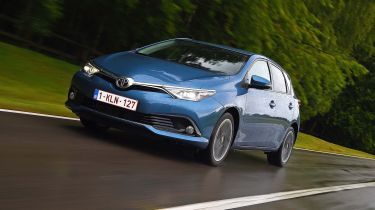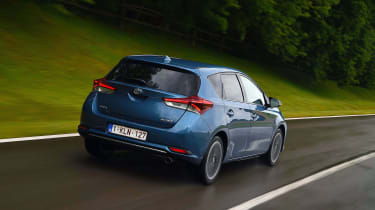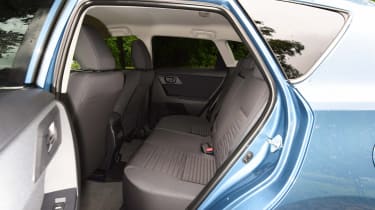New Toyota Auris 2015 review
Updates for the Toyota Auris have improved it quite a bit, but the hatch still lags behind rivals

The addition of a new 1.2-litre turbo petrol has made the Auris more competitive in the fiercely fought hatchback class. Tweaks to the suspension, some added steering feel and the updated styling are all welcome, but its nearest rivals are still more fun to drive and to look at. While the updated Auris is a definite improvement the competition has moved on too in the meantime, so it’s only enough to hold its position as the sensible all-rounder in the class.
Since the second-generation Toyota Auris arrived in 2012 there has been a raft of new and updated rivals all moving the game on with downsized engines, more daring styling and greater levels of kit. Without wanting its British-built hatchback to be left behind, Toyota has given its Auris a mid-life refresh to keep pace with the recently facelifted Ford Focus and Hyundai i30, plus Auto Express’s favourite family hatch the SEAT Leon.
Let’s start under the bonnet because at last Toyota has embraced the trend of fitting downsized engines with a new 110bhp BMW-sourced 1.6-litre diesel and a turbocharged 1.2-litre petrol. It’s the latter we’ve tested for the first time.
It’s a totally new engine and sits alongside the old 98bhp 1.33-litre petrol (now tweaked to meet Euro 6 emissions legislation) and allows the Auris to take on the Focus 1.0-litre EcoBoost, SEAT Leon 1.2 TSI and Peugeot’s 308 1.2 e-THP 130 without one hand tied behind its back. Like the SEAT, Toyota has opted for four-cylinders in its entry-level petrol and it means it’s noticeably quieter under hard revs compared to three-cylinder units in the Focus and 308.
It’s also a little bit smoother than the Focus and overtaking is easy if you keep the revs to between 1,500rpm and 4,000rpm. Fall out of this rev range and you’ll need to stir the gearbox to keep your momentum, fortunately the six-speed manual is slick to use.
Used - available now

2021 SEAT
Arona
13,926 milesManualPetrol1.0L
Cash £13,800
2022 Volkswagen
ID.3
32,354 milesAutomaticElectric
Cash £14,400
2023 Citroen
C5 Aircross
16,720 milesManualPetrol1.2L
Cash £17,387
2024 Kia
Stonic
11,381 milesManualPetrol1.0L
Cash £16,463Toyota’s 1.2 musters a healthy 114bhp, sitting between the 108bhp Leon 1.2 TSI and the 123bhp Focus 1.0 and with a combined fuel economy of 58.9mpg is a match for them too. CO2 emissions of 112g/km are also roughly on par with the Leon and 308 in the £30 a year tax bracket – the 108g/km Focus is £10 cheaper a year to tax.
Compared to slightly sluggish 1.33, the 1.2 is far more sprightly and a raft of subtle tweaks under the skin have made improved the old Auris’s woolly handling. There’s a new steering set-up that delivers more feel compared to the outgoing Auris, and new dampers give a more comfortable ride. The Auris always been softly-sprung anyway, but the new one is even more supple – the only downside is an even greater tendency for the body to lean through corners.
Push the Auris through country bends and the steering doesn’t weight up as well as a Focus or even a 308, but it’s a noticeable improvement from the old model. There’s also a fluidity lacking between steering, suspension, brakes and gearbox that VW Group cars like the SEAT Leon, Skoda Octavia and the VW Golf have nailed so well.
Apart from the dinky new engine, the Auris has also received some nip and tuck in the styling department, too. There’s a new front and rear bumper that makes the Auris look lower and wider, new front headlights with LED day-running lights and darkened light clusters at the rear. On the inside there’s a new seven-inch touchscreen (on all models apart from the entry-level car) and a 4.2-inch display in between the dials.
Build quality has been improved too but it lags behind the Leon and Skoda Octavia, and the touchscreen is not as simple to use as you’d find in the Focus. It’s still spacious, though – head and rear legroom are good as is boot capacity: 350 litres with the seats up (34 more than the Focus but 30 less than a Leon) and when all seats are folded there’s 1,200 litres on offer (just 10 less than the Leon). The seats also fold completely flat unlike the SEAT.
The Auris’s trim range has been broadened too with Business Edition and Design slotting in between Icon and top-spec Excel while Active still kicks off the range at £15,295. The 1.2 starts at £18,295 for the Icon which comes with 16-inch alloys, a reversing camera and a leather steering wheel and gearknob, but we’d rather opt for the Leon 1.2 TSI. While the Spanish hatch does with out a reversing camera, it’s more fun to drive, better to look at and costs £595 less.










